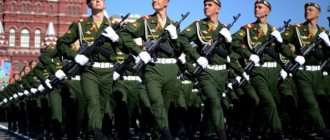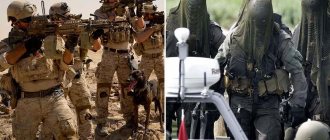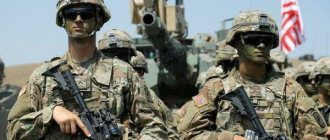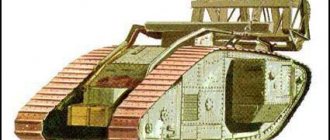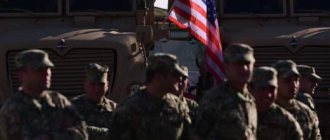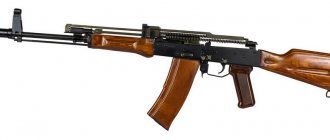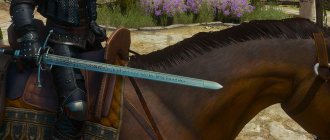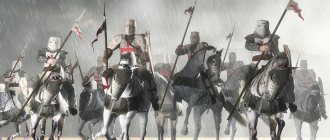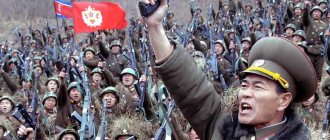From the very beginning of its independence, since 1991, Lithuania set a course for Western structures, both economic and defense, and overcame the path to them quite quickly. There are several reasons for this, including a relatively small population, a convenient strategic location, and certain traditions. Now the technology of European integration of this country to some extent serves as a model for the current leadership of Ukraine, which has set the task of transferring its armed forces to NATO standards. Lithuanian experience in this matter is invaluable, although it is unlikely that Kyiv will be able to copy it directly. First, you need to develop a military doctrine and compare it with the goals of the army of this Baltic country. This process will be of interest not only to Ukrainians.
Objectives of the Lithuanian Armed Forces
The task of the Lithuanian Army in the event of an attack by the enemy (meaning Russia, who else?) was formulated by the representative of the Department of Strategic Communication, Lieutenant Colonel Arturas Jasinskasov in the fall of 2013. It is quite simple - if a war starts, then you need to somehow hold out for a month, conducting “asymmetrical” actions, and then the NATO bloc will step in and help, and most likely, free you. It is difficult to say how realistic it is to achieve such a result in the hypothetical situation described by a high-ranking officer. North Atlantic analysts suggest that the Russian Armed Forces would need only three days to completely occupy not only Latvia, but also Lithuania and Estonia at the same time. It is possible that “asymmetry” refers to partisan and sabotage operations, which, as is known, cause damage to very strong armies, but nothing is said about this in the program statement. Instead, the emphasis is on the classic military organizational structure, with ground units, artillery, air force and navy.
Why science fiction writer Ray Bradbury had no doubt that Russia would become a superpower
Angela at mealtime! We prepare Lenten soup, as in the Trinity-Vladimir Cathedral
According to the doctor, memorizing pictures and images helps restore memory
[edit] International cooperation
Lithuanian military personnel have been involved in peacekeeping missions and operations since 1994. Lithuanian Armed Forces personnel performed peacekeeping missions in countries such as Croatia, Bosnia and Herzegovina, Albania, Georgia, Afghanistan, Macedonia, Iraq, Indonesia, Pakistan.[60]
As part of the military cooperation of the Baltic countries, Lithuanian components (along with Latvian and Estonian) are included in the peacekeeping battalion “Baltbat” and the joint Baltic mine action squadron “Baltron”. Lithuanian air defense components are included in the joint airspace control system of the Baltic countries - Baltnet. In addition, units of the 1st Infantry Brigade "Iron Wolf" perform tasks as part of the EU Rapid Reaction Force and the NATO International Security Assistance Force.[61]
Currently, there are about 240 of the country's military personnel in peacekeeping missions in Afghanistan: about 150 people are in the province of Ghor, in Kabul there are military personnel from the logistics department, in Kandahar there are air force instructors, and in the province of Zabul special forces personnel perform tasks.[62]
The plans of the leadership of the military department include a reduction in the number of Lithuanian military personnel stationed in Afghanistan. This will be achieved by transferring responsibility for the reconstruction of Ghor province to local authorities by the end of 2013.[63]
Ground troops
In 2011, Lithuania's defense budget was allocated $360 million, that is, approximately a million dollars a day. There are approximately 10,640 career military personnel in the country; there are another 6,700 trained specialists in the reserve who have experience in army service, including that gained in the Soviet Army, which is 14,600 soldiers and officers. Of the total number of peacetime personnel, ground units number 8,200 military personnel, organizationally divided into two motorized, two mechanized and one engineer battalions. The equipment is mixed, partly old Soviet (BRDM-2), but mostly American (M113A1), with a total of 187 light armored vehicles. The Lithuanian army also has artillery, these are 120-mm mortars (61 pieces), German Carl Gustaf guns (100 pieces), 18 anti-aircraft guns, as well as man-portable anti-tank and anti-aircraft systems.
Baltika khaki: what are the Armed Forces of Latvia, Lithuania and Estonia
The history of the armed forces of the three Baltic republics, as well as the history of Latvia, Lithuania and Estonia, has much in common. Period of independence between the two world wars, annexation to the USSR, German occupation, re-incorporation into the Soviet Union, declaration of independence in the early 1990s. All of these small states have rather weak armed forces and prefer to rely on their NATO allies.
Latvia
The Latvian National Armed Forces can be considered the heirs of the armed forces that existed before 1940 and included four ground divisions, a technical division, the Navy and various auxiliary units. After Latvia was included in the USSR, units of the Latvian army were transformed into the 24th Latvian Rifle Corps of the Red Army, which was operationally subordinate to the 27th Army. In August 1991, a law was passed in Latvia on the creation of the first paramilitary force, the National Guard, and after Latvia declared independence, the government began creating the armed forces.
Since 1994, Latvia has actively participated in the NATO Partnership for Peace program. And in March 2004, the republic joined the North Atlantic Alliance. Latvian military personnel participated in various international missions in hot spots: in the peacekeeping contingent in Bosnia and Herzegovina, in the KFOR contingent (Kosovo), in the occupation of Afghanistan and Iraq.
In mid-2005, the concept of standard small arms was adopted in Latvia, which provided for the gradual rearmament of the Latvian army with NATO standard weapons. At the same time, first of all, the units participating in the missions of the North Atlantic Alliance, as well as units intended to participate in international operations, were to be equipped with new weapons.
In November 2006, the Latvian army received the first batch of HK G36 assault rifles. In January 2007, universal conscription was abolished and a transition to a professional army took place.
The Latvian armed forces number about 5,000 military personnel and 10,000 reservists. Including more than 900 in the Ground Forces, 552 in the Navy, 250 in the Air Force. There are also more than 1,200 civilian employees in the armed forces. The 2012 military budget was 370 million euros.
The Latvian Land Forces include the following units and units: ground forces infantry brigade, special forces unit, armed forces headquarters battalion, military police, territorial defense forces, logistics department, training department.
In 2015, several CVRT tracked armored personnel carriers were delivered to Latvia, designed to improve the combat effectiveness and mobility of the ground forces infantry brigade. By 2022, the Latvian military should receive 123 of these tracked armored personnel carriers purchased from Great Britain. The Latvian army is also armed with American army all-terrain vehicles Humvee, which have high maneuverability and are suitable for air transport and landing.
Active negotiations are underway with Germany regarding the purchase of Panzerhaubitze 2000 self-propelled artillery mounts and infantry fighting vehicles. And in the summer of 2015, the commander of the Latvian armed forces told the press that his country would purchase Stinger man-portable anti-aircraft missile systems from the United States. It is expected that these MANPADS will be deployed at the largest military training ground in the Baltic countries - the Adazi military base.
The Latvian air force is small. In the early 2000s, two new Mi-8MTV helicopters were purchased, equipped with rescue and search equipment, but also used for transporting personnel, evacuation and supporting special forces. Then two more Mi-8MTVs were purchased. Previously, the Air Force was armed with the Polish training and sports aircraft PZL-104 Wilga, the Czechoslovak universal twin-engine aircraft Let L-410 Turbolet, the Soviet light multi-purpose aircraft An-2, and the Mi-2 helicopter.
It is not surprising that Latvia, which has a very modest air arsenal (as well as Lithuania and Estonia), is forced to use NATO, which alternately patrol the airspace of the Baltic republics. Since January 2016, this mission has been carried out by Belgian and Spanish military aircraft flying from a NATO military base in the Lithuanian city of Siauliai.
The Latvian naval forces number 587 military personnel and several ships, whose main task is demining territorial waters, as well as patrolling. The armed forces reserve consists of Latvian citizens who have completed military service (5,000 people). In the event of general mobilization, the army will receive 14 more light infantry battalions, one air defense battalion, one artillery battalion and several auxiliary units.
As of 2012, the strength of the Latvian State Border Guard was 2,500 people, armed with three helicopters, three patrol boats, 12 small patrol boats, four motor boats, two trucks, four buses, 11 off-road minibuses, 22 SUVs, 60 minibuses , 131 passenger cars, 30 ATVs, 17 motorcycles and seven tractors.
Lithuania
Until 1940, the Lithuanian armed forces were called the Lithuanian Army. After the republic was included in the USSR, it was reorganized into the 29th Territorial Rifle Corps of the Red Army. In January 1992, the Ministry of Regional Protection began its activities. At the same time, the first call for active military service was announced. In November 1992, the re-establishment of the Army of the Republic of Lithuania was proclaimed.
Continuing the traditions of the Lithuanian Troops of the interwar period, many battalions of the modern Lithuanian Army were given the names of regiments of the 1920s and 1930s and their symbols. The modern armed forces of Lithuania consist of the Ground Forces, Navy, Air Force and Special Operations Forces.
In September 2008, conscription for military service was abolished in Lithuania, and the Lithuanian armed forces are now recruited on a professional basis. However, in 2015, conscription was “temporarily” restored - under the pretext of the “Russian threat” and the fact that many units were understaffed. At the same time, young people aged 19 to 26 years are called up, selected using a computer draw.
As of 2011, the military budget of Lithuania was 360 million US dollars (later it increased several times, approaching $500,000), the total number of armed forces was 10,640 career military personnel, 6,700 reservists, another 14.6 thousand served in other paramilitary forces.
The Ground Forces have more than eight thousand military personnel (a rapid reaction force brigade, two motorized infantry battalions, two mechanized battalions, an engineer battalion, a military police battalion, a training regiment and several territorial defense units). There are 187 M113A1 armored personnel carriers in service; ten BRDM-2; 133 105 mm field artillery guns; 61 120-mm mortars, up to 100 84-mm recoilless Carl Gustaf guns, 65 ATGMs, 18 anti-aircraft guns and 20 RBS-70 man-portable air defense systems, as well as over 400 anti-tank grenade launchers of various systems.
The Lithuanian Air Force has less than one thousand personnel, two L-39ZA aircraft, five transport aircraft (two L-410 and three C-27J) and nine Mi-8 transport helicopters. More than 500 people serve in the Lithuanian Navy.
The naval forces are armed with one Project 1124M small anti-submarine ship, three Danish Flyvefisken class patrol ships, one Norwegian Storm class patrol boat, three other types of patrol boats, two English-built Lindau minesweepers (M53 and M54), one mine-laying headquarters ship. Norwegian-built mine sweeping forces, one hydrographic vessel and one tug. There is also a coast guard (540 personnel and three patrol boats).
Like the other Baltic republics, Lithuania began cooperation with the North Atlantic Alliance under the Partnership for Peace program in 1994, which continued until it joined NATO in March 2004. Lithuanian military personnel took part in missions in Bosnia, Kosovo, Afghanistan and Iraq. After Lithuania joined NATO, the integration of the country's armed forces with the armed forces of other alliance countries began.
In particular, the Lithuanian motorized brigade "Iron Wolf" was included in the Danish division, and in 2007 an agreement was signed on the creation of an infantry battalion of NATO priority deployment forces by Estonia, Latvia and Lithuania. In September 2015, NATO headquarters opened in Vilnius (similar ones were also opened in Estonia, Latvia, Bulgaria, Poland and Romania), which employs 40 military personnel from alliance member countries (primarily Germany, Canada and Poland). One of its main tasks is the coordination of the North Atlantic Alliance's rapid reaction forces in the event of an international crisis in the region.
Estonia
The modern armed forces of Estonia (Estonian Defense Army) in peacetime number about 5.5 thousand people, of which about two thousand are conscripts. The reserve force of the armed forces is about 30,000 people, which allows the full strength of one infantry brigade, four separate battalions and the organization of four defensive areas. Additionally, there are more than 12 thousand people who are members of the Defense League (the so-called Defense League, a volunteer paramilitary force).
The Estonian armed forces are recruited on the basis of universal conscription. Young men from 18 to 28 years of age who do not have an exemption and who are Estonian citizens are required to serve an eight-month or 11-month service (certain specialists). The largest part of the armed forces is the Ground Forces. The priority for their development is the ability to participate in missions outside the national territory and carry out operations to protect the territory of Estonia, including in cooperation with allies.
Along with a number of Soviet-made armored vehicles, the Estonian army is armed with several dozen Swedish Strf 90 infantry fighting vehicles, Finnish armored personnel carriers Patria Pasi XA-180EST and Patria Pasi XA-188.
The main functions of the Estonian Navy are the protection of territorial waters and coastlines, ensuring the safety of maritime navigation, communications and maritime transport in territorial waters and cooperation with the NATO Navy. Naval forces include patrol ships, minesweepers (Sandown class minesweepers), auxiliary ships and coast guard units. Separately, it is worth mentioning the voluntary military organization “Defence League,” subordinate to the Ministry of Defense.
It consists of 15 territorial divisions, the areas of responsibility of which largely coincide with the boundaries of the Estonian counties. This organization takes part in the exercises of the Estonian army, in addition, its activists participate in maintaining public order as voluntary police assistants, in extinguishing forest fires and performing some other public functions.
Like the other Baltic states, Estonia is a member of the North Atlantic Alliance and has high hopes for its allies. Thus, in the spring of 2015, Estonian President Toomas Hendrik Ilves called for the deployment of NATO forces in the country on a permanent basis (at least a brigade). And over the past year, the Estonian Air Force participated several times in joint exercises with the US Air Force: American attack aircraft flew in the Estonian sky and a training airborne landing was carried out.
A small Estonian contingent took part in the war in Afghanistan as part of the international ISAF force, as well as in the American occupation of Iraq. A small number of Estonian representatives took part in UN, EU and NATO peacekeeping missions in Lebanon, Mali, Kosovo and the Middle East.
Author: Andrey Yashlavsky
Air Force
980 soldiers and officers serving at three air force bases in five squadrons are considered aviators in Lithuania. At the same time, there are only sixteen units of flying equipment. This is not much, but the Ukrainian troops, for example, should not worry too much, since after the failures over the Donbass, Kiev has little more left, if not much. There are practically no fighters, attack aircraft and bombers in the Lithuanian Air Force, unless you count the combat training Czech L-39ZA, capable of delivering strikes in the event of absolute air supremacy. There are also L-410 transport aircraft (small, 2 pcs.) and C-27J (3 pcs.), as well as Mi-8 helicopters (9 pcs.). That's all Lithuania's air power.
As it turned out, 10% of people in the world do not respond to the COVID-19 vaccine
Effortlessly get snow-white laundry: the proven salt and vinegar bleaching method
For the sake of shelf life: for what purpose is ascorbic acid added to products?
Fleet
There are 530 sailors serving in the Lithuanian Navy. They make up the coastal personnel, the crews of one small Soviet-built Project 1124M anti-submarine ship, three Fluvefisken class patrol boats (Aukshaitis, Dzukas and Žemaitis), three Storm-class patrol boats (Skalvis, M-53 and M -54), as well as the headquarters ship, also called “Skalvis”. There is also a tugboat, a hydrographic ship and three more small border patrol boats (N-21-N23). The composition of the Lithuanian fleet is currently comparable to the Ukrainian one. There are 540 sailors serving in the Coast Guard.
Mobilization potential and equipment in peacetime
In the event of the outbreak of war, healthy men from 16 to 49 years old are subject to mobilization; there are more than 910 thousand of them in the country (as of 2011), and approximately the same number of women of the same age. In peacetime, the armed forces are recruited according to a mixed contract-conscription principle. At the same time, the number of people willing to serve voluntarily has recently decreased significantly, and of the 23.5 thousand people reaching conscription age (in the range of 19-26 years), only two-thirds remain in the country, the rest leave to work in Europe. In connection with this circumstance, Lithuanian President Dalia Grybauskaite resumed conscription into the army, which had not previously been practiced.
In Colombia, firefighters were called to remove a flock of goats from the roof of a house - photo
Twitter will introduce an alternative to Clubhouse - Spaces - by April 2021
Russians consider 5,000 rubles a comfortable loan payment.
[edit] Notes
- Armed Forces of Lithuania[1] // Belarusian Military Newspaper, No. 218 11/16/2011
- Armed Forces of Lithuania[2] // Belarusian Military Newspaper, No. 218 11/16/2011
- Armed Forces of Lithuania[3] // Belarusian Military Newspaper, No. 218 11/16/2011
- Armed Forces of Lithuania[4] // Belarusian Military Newspaper, No. 218 11/16/2011
- Armed Forces of Lithuania[5] // Belarusian Military Newspaper, No. 218 11/16/2011
- Armed Forces of Lithuania[6] // Belarusian Military Newspaper, No. 218 11/16/2011
- Armed Forces of Lithuania[7] // Belarusian Military Newspaper, No. 218 11/16/2011
- Armed Forces of Lithuania[8] // Belarusian Military Newspaper, No. 218 11/16/2011
- Armed Forces of Lithuania[9] // Belarusian Military Newspaper, No. 218 11/16/2011
- Armed Forces of Lithuania[10] // Belarusian Military Newspaper, No. 218 11/16/2011
- Armed Forces of Lithuania[11] // Belarusian Military Newspaper, No. 218 11/16/2011
- Armed Forces of Lithuania[12] // Belarusian Military Newspaper, No. 218 11/16/2011
- Armed Forces of Lithuania[13] // Belarusian Military Newspaper, No. 218 11/16/2011
- Armed Forces of Lithuania[14] // Belarusian Military Newspaper, No. 218 11/16/2011
- Armed Forces of Lithuania[15] // Belarusian Military Newspaper, No. 218 11/16/2011
- Armed Forces of Lithuania[16] // Belarusian Military Newspaper, No. 218 11/16/2011
- Armed Forces of Lithuania[17] // Belarusian Military Newspaper, No. 218 11/16/2011
- Armed Forces of Lithuania[18] // Belarusian Military Newspaper, No. 218 11/16/2011
- Armed Forces of Lithuania[19] // Belarusian Military Newspaper, No. 218 11/16/2011
- Armed Forces of Lithuania[20] // Belarusian Military Newspaper, No. 218 11/16/2011
- Armed Forces of Lithuania[21] // Belarusian Military Newspaper, No. 218 11/16/2011
- Armed Forces of Lithuania[22] // Belarusian Military Newspaper, No. 218 11/16/2011
- Armed Forces of Lithuania[23] // Belarusian Military Newspaper, No. 218 11/16/2011
- Armed Forces of Lithuania[24] // Belarusian Military Newspaper, No. 218 11/16/2011
- Armed Forces of Lithuania[25] // Belarusian Military Newspaper, No. 218 11/16/2011
- Armed Forces of Lithuania[26] // Belarusian Military Newspaper, No. 218 11/16/2011
- Armed Forces of Lithuania[27] // Belarusian Military Newspaper, No. 218 11/16/2011
- Armed Forces of Lithuania[28] // Belarusian Military Newspaper, No. 218 11/16/2011
- Armed Forces of Lithuania[29] // Belarusian Military Newspaper, No. 218 11/16/2011
- Armed Forces of Lithuania[30] // Belarusian Military Newspaper, No. 218 11/16/2011
- Armed Forces of Lithuania[31] // Belarusian Military Newspaper, No. 218 11/16/2011
- Armed Forces of Lithuania[32] // Belarusian Military Newspaper, No. 218 11/16/2011
- Armed Forces of Lithuania[33] // Belarusian Military Newspaper, No. 218 11/16/2011
- Armed Forces of Lithuania[34] // Belarusian Military Newspaper, No. 218 11/16/2011
- Armed Forces of Lithuania[35] // Belarusian Military Newspaper, No. 218 11/16/2011
- Armed Forces of Lithuania[36] // Belarusian Military Newspaper, No. 218 11/16/2011
- Armed Forces of Lithuania[37] // Belarusian Military Newspaper, No. 218 11/16/2011
- Armed Forces of Lithuania[38] // Belarusian Military Newspaper, No. 218 11/16/2011
- Armed Forces of Lithuania[39] // Belarusian Military Newspaper, No. 218 11/16/2011
- Armed Forces of Lithuania[40] // Belarusian Military Newspaper, No. 218 11/16/2011
- Armed Forces of Lithuania[41] // Belarusian Military Newspaper, No. 218 11/16/2011
- Armed Forces of Lithuania[42] // Belarusian Military Newspaper, No. 218 11/16/2011
- Armed Forces of Lithuania[43] // Belarusian Military Newspaper, No. 218 11/16/2011
- Armed Forces of Lithuania[44] // Belarusian Military Newspaper, No. 218 11/16/2011
- Armed Forces of Lithuania[45] // Belarusian Military Newspaper, No. 218 11/16/2011
- Armed Forces of Lithuania[46] // Belarusian Military Newspaper, No. 218 11/16/2011
- Armed Forces of Lithuania[47] // Belarusian Military Newspaper, No. 218 11/16/2011
- Armed Forces of Lithuania[48] // Belarusian Military Newspaper, No. 218 11/16/2011
- Armed Forces of Lithuania[49] // Belarusian Military Newspaper, No. 218 11/16/2011
- Armed Forces of Lithuania[50] // Belarusian Military Newspaper, No. 218 11/16/2011
- Armed Forces of Lithuania[51] // Belarusian Military Newspaper, No. 218 11/16/2011
- Armed Forces of Lithuania[52] // Belarusian Military Newspaper, No. 218 11/16/2011
- Armed Forces of Lithuania[53] // Belarusian Military Newspaper, No. 218 11/16/2011
- Armed Forces of Lithuania[54] // Belarusian Military Newspaper, No. 218 11/16/2011
- Armed Forces of Lithuania[55] // Belarusian Military Newspaper, No. 218 11/16/2011
- Armed Forces of Lithuania[56] // Belarusian Military Newspaper, No. 218 11/16/2011
- Armed Forces of Lithuania[57] // Belarusian Military Newspaper, No. 218 11/16/2011
- Armed Forces of Lithuania[58] // Belarusian Military Newspaper, No. 218 11/16/2011
- Armed Forces of Lithuania[59] // Belarusian Military Newspaper, No. 218 11/16/2011
- Armed Forces of Lithuania[60] // Belarusian Military Newspaper, No. 218 11/16/2011
- Armed Forces of Lithuania[61] // Belarusian Military Newspaper, No. 218 11/16/2011
- Armed Forces of Lithuania[62] // Belarusian Military Newspaper, No. 218 11/16/2011
- Armed Forces of Lithuania[63] // Belarusian Military Newspaper, No. 218 11/16/2011
- [64]
| Armed forces | |
| Europe | Austria • Albania • Andorra • Belarus • Belgium • Bulgaria • Bosnia and Herzegovina • Vatican City • Great Britain • Hungary • Germany • Greece • Denmark • Ireland • Iceland • Spain • Italy • Latvia • Lithuania • Liechtenstein • Luxembourg • Macedonia • Malta • Moldova • Monaco • Netherlands • Norway • Poland • Portugal • Russia • Romania • San Marino • Serbia • Slovakia • Slovenia • Ukraine • Finland • France • Croatia • Montenegro • Czech Republic • Switzerland • Sweden • Estonia |
| Asia | Abkhazia • Azerbaijan • Armenia • Afghanistan • Bangladesh • Bahrain • Brunei • Bhutan • East Timor • Vietnam • Georgia • Israel • India • Indonesia • Jordan • Iraq • Iran • Yemen • Kazakhstan • Cambodia • Qatar • Cyprus • Kyrgyzstan • China • North Korea • Kuwait • Laos • Lebanon • Malaysia • Maldives • Mongolia • Myanmar • Nepal • UAE • Oman • Pakistan • Palestine • Saudi Arabia • Singapore • Syria • Tajikistan • Thailand • Turkmenistan • Turkey • Uzbekistan • Philippines • Sri Lanka • South Korea • South Ossetia • Japan |
| America | Anguilla • Antigua and Barbuda • Argentina • Aruba • Bahamas • Barbados • Belize • Bolivia • Brazil • Venezuela • Haiti • Guatemala • Honduras • Grenada • Dominica • Dominican Republic • Canada • Colombia • Costa Rica • Cuba • Mexico • Nicaragua • Panama • Paraguay • Peru • El Salvador • Saint Vincent and the Grenadines • Saint Kitts and Nevis • Saint Lucia • USA • Suriname • Trinidad and Tobago • Uruguay • Chile • Ecuador • Jamaica |
| Africa | Algeria • Angola • Benin • Botswana • Burkina Faso • Burundi • Gabon • Gambia • Ghana • Guinea • Guinea-Bissau • Djibouti • DR Congo • Egypt • Zambia • Western Sahara • Zimbabwe • Cape Verde • Cameroon • Kenya • Comoros • Republic Congo • Cote d'Ivoire • Lesotho • Liberia • Libya • Mauritius • Mauritania • Madagascar • Malawi • Mali • Morocco • Mozambique • Namibia • Niger • Nigeria • Rwanda • Sao Tome and Principe • Swaziland • Seychelles • Senegal • Somalia • Sudan • Sierra Leone • Tanzania • Togo • Tunisia • Uganda • Central African Republic • Chad • Equatorial Guinea • Eritrea • Ethiopia • South Africa |
| Australia and Oceania | Australia • New Zealand • Palau • Vanuatu • Kiribati • Marshall Islands • Nauru • Papua New Guinea • Samoa • Solomon Islands • Tonga • Tuvalu • Federated States of Micronesia • Fiji |
Source - ""
Category: Lithuanian Armed Forces
Combat training
It is difficult, if not impossible, to train a highly professional military man in 9 months, but given the limited availability of equipment, it should be assumed that the bulk of conscripts enter motorized rifle units. An exercise with the loud name “Fire Salvo - 2016” is planned for this summer, in which self-propelled guns of the battalion named after. Romualdas Giedraitis under the command of Lieutenant General Ausrius Buikus. There are four such cars in Lithuania, and the Germans will bring the same number for this occasion; their arrival is expected in May. These maneuvers will be held for the first time in many years with the participation of conscripts. The shooting involves practicing suppression of mock enemy batteries at distances of up to 40 km. German equipment is being given as a test, and based on the results of the exercises, a decision will be made on the purchase of another 16 units of self-propelled artillery units that were used by the Bundeswehr. This is where a very interesting pattern begins to emerge.
“Second Front” of Khmelnytsky region: Lithuanian army
The most important events of the Cossack uprising, which began in 1648, took place in the Kingdom of Poland. Khmelnitsky's main efforts, of course, were aimed at persuading Warsaw, and not Vilna, to peace. Does this mean that the Grand Duchy of Lithuania remained on the sidelines? In no case. Moreover, many heated battles took place on Lithuanian lands. And it was here that a commander appeared, who could rightfully be called the best sword of the then Polish-Lithuanian Commonwealth.
Principality of pacifists?
First, let's try to assess what kind of regular troops the Principality had at the time the uprising began. At first glance – almost none. This may seem incredible, but in peacetime, an area of several hundred thousand square kilometers contained... less than a thousand fighters. And not the elite guard, as one might assume, but only the garrisons of four fortresses: Smolensk, Dinaburg (Dvinsk), Polotsk and Vilna. At the same time, the collected taxes were sometimes not enough even for such a tiny army, and money had to be borrowed from private individuals to pay for future fees.
Grand Duchy of Lithuania in the middle of the 17th century Source: velikoe-knyazhestvo-litovskoe.wikitix.ru
The rest of the army was gathered only in case of war, and for a clearly limited period, after which the soldiers could safely go home. The largest contingent was theoretically the “Pospolita Rushenie” - the militia of the principality, the commander of which was considered the king himself. It was considered the sacred duty of every landowner to serve in it. And not only the nobles - the clergy (!), excluding the Jesuit college, and the Lithuanian Tatars, and the burghers of the royal cities had to serve in the destruction. Those who did not appear at the militia meetings were to be deprived of all property. The decision to gather militias was made by the Diet of the Principality, after which the king confirmed the collection and determined the duration of service - thus, theoretically, the state could field up to 25,000 cavalry.
In practice, the situation was as follows. No one was able to gather the required 25,000 people - and not even because not all of the gentry wanted to serve. First of all, there was absolutely no point in wasting effort and money gathering a huge crowd of people. Moreover, a people who have no idea about modern war, and often about military affairs in general, but who know their rights and liberties very well, and therefore are not inclined to discipline. Even in those rare cases when part of the militia gathered, this violent horde could only be entrusted with auxiliary roles - supporting more organized detachments, covering secondary directions, and so on.
Drunk nobles in a military camp. Still from Jerzy Hoffmann’s film “With Fire and Sword”
Local, private and mercenary troops
In case of danger threatening the internal districts and voivodeships of the principality, some of the militias could gather locally - they were better suited for the defense of their native fields. Usually such a detachment was commanded by a local marshal or cornet, or, in their absence, by a troop (zemstvo official).
Since the collection of even a small part of the destruction required a sanction from the Val Sejm, the local gentry usually did not try to achieve its convocation and, instead of the militia, collected “povet banners”. In essence, these were the same militias, but they gathered directly in their native district. The banner was headed by a captain, assisted by a lieutenant and a cornet. The most authoritative nobles traditionally became captains, the cavalry received firearms, and the infantry received uniforms. Typically, “povetovs” were hired for three months: first of all, Cossack and hussar detachments, sometimes reiters or arquebusiers, and from time to time dragoons and infantry. The combat effectiveness of such troops depended on each specific case, but they were suitable for the defense of their native districts.
The next type of army that Lithuania could count on were the private armies of magnates. There are stereotypes that, in contrast to the weak state army, the magnate of the Principality had gigantic combat-ready contingents (it’s hard not to remember the novelist Valentin Pikul, who “endowed” Carol Radziwill with a corps of 25,000 loyal horsemen). However, the reality was much more prosaic - in comparison with the huge regiments of the Vishnevetsky, Zaslavsky, Koniecpolsky and other Polish “kings”, the Lithuanian elite could boast of very modest detachments. The full Hetman of Lithuania Kryshtof Radziwill himself in 1640 could field only 100 Tatar horsemen and 60 dragoons, and his son Janusz Radziwill in 1648 had 200 dragoons and 100 haiduks. Of course, in the event of war, the magnates could have acquired much more serious troops, but in general, the private armies of the Lithuanian elite were a rather pitiful sight.
Grand Hetman of Lithuania Kryštof Radziwill Source: war16–17.blogspot.com.by
In such conditions, the most combat-ready warriors of the Principality, willy-nilly, became mercenaries. The market for mercenary soldiers both inside Lithuania and abroad was plentiful and varied - the just ended Thirty Years' War released tens of thousands of men who lived in war to “freedom.”
"Worried, the cavalry flies"
The mercenaries were clearly divided into troops of “national” and “foreign” recruitment. The basis of the national army, according to tradition, was cavalry - reiters, Cossacks, Tatars and the famous winged hussars. The only tactical and organizational unit of mercenary cavalry was a company or banner under the command of a captain (several banners could be combined into a regiment, but it was not a permanent tactical unit). The captain also hired soldiers - for this he was given a special letter. The text of the letter was standard and has survived to this day:
“Knowing the love of Your Faithfulness to the Lord and the Fatherland and no less - your knightly skill, we call upon Your Faithfulness, providing the number of people [the number of those hired is inserted here - usually 50, 100, 150 and so on - approx. author], capable of war, having been in campaigns, appeared on the designated day and place in all order and readiness.”
Hussar captain Source: essaystudents.ru
To facilitate recruitment, the captain was usually given the required amount of money along with the letter. Usually there were no problems with the recruitment - the numerous campaigns that the Polish-Lithuanian Commonwealth waged on different fronts formed a large layer of experienced craftsmen who were always ready for work. Therefore, the approximate personnel of a particular banner and the name of its commander were most often known in advance. The recruitment of national cavalry was worked out well, and in a short time it was possible to field combat-ready troops. So, in 1620, the captain was given only two months to collect the banner, and two weeks to bring it to the camp.
The banner was divided into “detachments” (“travelling”, “retinues”), consisting of a cavalryman and his subordinates who were in battle next to the “chief”. It is easy to understand that such a system completely repeated the medieval system of knights, which were also divided into banners (gonfalons), consisting of copies (knights and their retinues). It is logical that the richer the nobleman was, the more servants he could place in his detachment. It is no less logical that the banners from small trips were most valued - the army needed full-fledged fighters, and not their servants.
Traveling (hussar and two servants) in the camp Source: Brzezinski R., Vuksic V. Polish winged hussar 1500–1775
Calculations between the captain and the soldiers in the national cavalry usually avoided abuses, which was common in foreign mercenary troops. The commander of the banner usually received his income from the so-called “blind portions.” Their essence was that any captain, lieutenant and cornet had the right to receive money to form his own retinue - usually it went straight to the commander’s pocket (this was not considered corruption). Because of this, the actual number of fighters in the unit was usually 10–12% less than on paper. Another thing is that the money to pay the troops was often delayed by the treasury itself, so that even the most honest commander was faced with a choice - not to pay or, if possible, to pay the soldiers from personal funds.
Supplying the cavalry was the work of the cavalry itself - the cavalrymen had their own carts, which made up the convoy, which sometimes served as a field fortification. In 1632, an eyewitness wrote that for 60 hussars he counted 225 carts, of which almost half were four- and even six-horse: “Three or four banners of infantry in full armor could be fed with what this flock ate in one position.”
. At the same time, there were still fewer carts “per capita” in the Lithuanian army than in the Polish army - according to some information, by half.
Transport servants and magnates' servants were officially considered non-combatants and were not recorded in the army register. The warriors contemptuously called the convoys “kurolov” for their low combat effectiveness and love of robbery.
The eternal problem of the Lithuanian army was the quality of horses. If in Poland, through the selection of Western European Frisians and Arabian horses, it was possible to develop a magnificent breed that was famous throughout Europe, then in Lithuania the cavalry used much lower quality horses. Papal Nuncio Juliusz Ruzhary wrote in a report:
“Polish horses are very brave, quite tall and beautiful... but Lithuanian horses are much smaller and weaker than Polish ones; one might even say that 10,000 Polish cavalry are equivalent to 20,000 Lithuanian cavalry.”
The elite of the cavalry of that time were the legendary winged hussars, whose main tactic was attacking with pikes in formation. Crushing blows, when one lance pierced two, three or even five opponents, may have taken place, but some skepticism in this regard is quite acceptable. A blow with a long pike from acceleration was certainly crushing, but the fragility of the shafts of hussar pikes was well known, and they did not always hit targets in armor. In 1627, the Swedish colonel Claes Dietrich was awarded the nickname Sperreuter (“lancer”) by his fellow soldiers because the lances of no less than three hussars broke on his steel breastplate in battle. However, in the fight against unarmored infantry and cavalry, pikes were effective.
The combat effectiveness of the Lithuanian hussar army seems very controversial. On the one hand, the hussars were rightfully proud of their high-profile victories (such as the Battle of Kirchholm in 1605), on the other, the discipline and stamina of the “winged” were often below any criticism. The Lithuanian hetman Kryštof Radziwill recalled that in 1622, near Mitau, he “galloped from one company to another, promising to lead the soldiers personally, threatening them with the gallows, promising them rewards, but nothing helped.”
– Swedish musket and artillery fire turned out to be a more convincing argument. Sometimes hussars deserted en masse, even during successful campaigns.
Jan Chodkiewicz near Kirchholm. Painting by Juliusz Kossak Source: war16–17.blogspot.ru
The last thing worth saying about the hussars is the rarely mentioned fact that it was not necessary to wear their legendary wings. One of the letters to the hussars directly states: “Feathers and other decorations for the sake of grandeur and in order to frighten the enemy depend on everyone’s preferences.”
. Going on an attack with wings on your back was apparently not very convenient, and warriors often sacrificed showiness for the sake of efficiency.
Another type of cavalry were reiters - traditional European cavalry, able to fight hand-to-hand and shoot the enemy with pistols and muskets. There was an acute shortage of good personnel to replenish the Reitar banners in the Grand Duchy of Lithuania, and therefore Reitars from the German lands were in particular demand. It is interesting that among their special advantages it was stated that the Germans “do not shy away from guard duty”
, which the freedom-loving Lithuanians and Poles did not tolerate.
The medium and light cavalry were represented by the Cossack cavalry, which in turn was subdivided into the Pyatigorsk, Tatar and Cossack cavalry itself (or panzer cavalry). Among the Cossacks, only armored ones were armored, dressed in chain mail made of rectangular rings and sometimes had shields. A special Lithuanian type of cavalry were the Pyatigorsk, essentially light lancers with spears or long pikes. According to another version, the Pyatigorsk people were simply a Lithuanian version of the “panzer” Cossacks and were no different from them.
Panzer Cossack Source: ru.warriors.wikia.com
The Tatar cavalry played the role of the lightest cavalry - they fought, mostly without armor, on light, hardy horses, and were used for reconnaissance, shooting at the enemy with bows and chasing the retreating.
Lithuanian Tatars Source: Brzezinski R. Polish Armies 1569–1696 (2)
The intermediate niche between cavalry and infantry was occupied by dragoons, who rode on horseback, but usually fought on foot.
"Queen of the Fields" and "God of War"
If most European powers in the 17th century had already made infantry the basis of their armies, then in the Grand Duchy of Lithuania they did not want to hear about it. For the Principality, foot troops were a severe necessity in the war with Sweden, a compromise with reality, but not the “queen of the fields.” Like the cavalry, the infantry was foreign (called “German”) and national (“Polish”). The most combat-ready units were formed from Germans, organized into regiments and receiving the highest salaries, sometimes not inferior to those of the hussars. The infantry consisted of pikemen and musketeers, approximately 1:3 in number (trained pikemen were valued higher). In battle, the infantrymen copied the six-rank battalion formation: pikemen in the center, musketeers on the flanks.
The national or “Polish” infantry was divided into the same banners under the command of captains - usually 100 people each. As in the cavalry, the captain was assisted by one or two lieutenants, as well as a cornet. The infantrymen were armed with matchlock muskets, handguns and sabers; in battle they lined up in 9–10 ranks and fired in rows, starting from the last. The first row of infantry sometimes consisted of foremen with pikes and was supposed to cover the musketeers from mounted attacks, although the effectiveness of cover from a single row of pikes raises reasonable doubts. Unlike the German infantry, the “Polish” infantry received little money, but the soldiers were given fabric for their uniforms. Thanks to the large number of muskets, the potential firepower of the national infantry was high, but dense fire required good training, and the commanders of the Lithuanian army in most cases considered the qualifications of their fighters unsatisfactory. Serving as a musketeer was unprofitable and unprestigious, and there was an irreverent saying about them: “Polish infantry is a small value [small virtue – author’s note].”
.
Infantry and dragoons of the Grand Duchy of Lithuania Source: Brzezinski R. Polish Armies 1569–1696 (2)
Artillery received even less attention from the authorities than infantry. Despite the impressive collections of Lithuanian cannons, similar to Radziwill’s, in the army of the Principality itself, things were bad with the “god of war”. The basis of the artillery fleet were six-pounder 14-caliber light field guns, in addition, there were a number of three-pounder ones. Due to the lack of copper deposits of our own, guns often had to be made of iron (that is, inferior in quality to “normal” guns).
More powerful was the private artillery of the magnates - primarily the Radziwills, Chodkiewiczs, Dorogostaiskis and Sapiehas. King Vladislav IV, being a big fan of artillery, sought to develop this type of military in every possible way. In particular, in 1638 the position of artillery general of the Grand Duchy was introduced (in Poland this post appeared a year earlier). However, this innovation did not bring much practical benefit.
Commander Fathers
But, as you know, weapons do not fire by themselves, and someone must control the army. What was the situation with this in Lithuania? According to the law, the Great Hetman of Lithuania was supposed to lead the troops of the Principality during the war - in 1648 this post was occupied by the old warrior Janusz Kiszka. Back in 1605, he smashed the Swedes together with Jan Chodkiewicz, then took part in a campaign against Moscow, in 1611 he defeated a detachment sent to help Smolensk, fought with the Turks near Khotyn in 1621, and a year later led a dashing hussar attack on the Swedes near Jelgava . During the Smolensk War, Kishka fought at the head of his own Cossack banner and defended Polotsk. In 1646, he sought the coveted mace of the Great Hetman - and received it, already being a deeply ill old man. As a military leader, he was of little use, and therefore simply withdrew from business.
Thirty-six-year-old Janusz Radziwill was the Polish hetman and the most promising military leader of the Principality. He was brilliantly educated, studied military and fortification affairs in Holland and had experience of the Smolensk War. Like Bohdan Khmelnitsky, Radziwill participated in the attempts of King Wladyslaw IV to start a war with the Ottoman Empire - his task was to win Moldavia and Transylvania to the side of the Polish-Lithuanian Commonwealth.
Janusz Radziwill, portrait by Daniel Schulz Source: nn.by
Radziwill enjoyed considerable authority among the soldiers - he was respected and feared. With his will, this man could stop the army, not allowing him to enter the already occupied city in order to engage in “legal” robbery. During one of the campaigns, Radziwill ordered the arrest of soldiers who robbed a shop and a search of their apartments. You need to understand that in the princely and crown troops, with their traditions of gentry equality and weak discipline, this was almost unrealistic - for example, Hetman Stanislav Zholkiewski himself, the most authoritative commander, caused a revolt of his soldiers with just one attempt to search the carts of his servants. Radziwill had not yet shown himself as a military leader, but everything was ahead.
There were other commanders in the Lithuanian army, many of whom subsequently covered themselves with glory in the fire of the Khmelnytsky region. But more on this in the following articles.
To be continued
Bibliography:
- Brzezinski R. Polish Armies 1569–1696. (1) / R. Brzezinski – Oxford: Osprey, 1987. – 56 p.
- Brzezinski R. Polish Armies 1569–1696 (2). / R. Brzezinski – Oxford: Osprey, 1987. – 55 p.
- Brzezinski R., Vuksic V. Polish winged hussar 1500–1775. / R. Brzezinski, V. Vuksic. – Oxford: Osprey, 2005. – 64 p.
- Byarnatski V. Paustanne Khmyalnitskaya: Wars in Lithuania 1648–1649. / Per. z floor Anton Kuzmich. – Vilnya: Institute of Belarusisty; Belastok: Belarusian State Trade Association, 2010. – 184 p.
- Maeўski A. Uzyatstse Pinsk to the troops of the Grand Duchy of Lithuania near Listapadze 1648 / per z pol. Alex Monich // Arche. – 2015. – No. 12 – pp. 9–16
- Saganovich G. Troops of the Vyalikag Principality of Lithuania in the XVI-XVII centuries. / G. Saganovich. – Mn.: Navuka and technology, 1994. – 79 p.
- Sikora R. The history of the Polish winged hussars. / lane z floor Lesya Lisenko. – Kiev: Spirit and literature, 2012. – 96 p.
How to spend Lithuania's defense budget?
Lithuania spends significantly less than the NATO two percent of its state budget on defense. She is not alone in this; many states of the Alliance ignore this requirement, which upsets the leadership of the main members, and also the sponsors of this organization. Therefore, Vilnius is constantly being encouraged to acquire at least some models, not new ones, but at least devastating in NATO style (as today’s owners of old weapons assure). In particular, out of 16 Bundeswehr installations, three will have to be immediately disassembled for spare parts in order to repair the rest, which will certainly scare away all aggressors, and primarily Russian ones. Among the enviable and extremely necessary acquisitions are also M577 command and staff vehicles (26 units), produced at different times (mainly in the 60s), armored repair and recovery vehicles BPz-2 (6 units) and other time-tested military units. technicians who have served their time in “first-class” armies and now have a 100% chance of serving the cause of democracy at the forefront of defense.
Lithuanian Defense Minister: Russia may attack Ukraine in the coming hours
Lithuanian Defense Minister Arvydas Anusauskas said that “Russia’s ability to use armed forces concentrated near Ukraine or in Belarus for a conflict, previously measured in weeks, is now measured in hours,” writes Delfi.lt.
According to the Lithuanian minister, he does not exclude that a Russian attack on Ukraine could take place as early as this or next week. According to Anusauskas, Moscow may order the attack in order to secure a better position in negotiations with the United States and NATO countries.
“The situation is that in the area of our eastern border we will soon become neighbors with Russia in a military sense. In a sense, we have already received it. It is known that their military base has been created near Grodno, that Russian aviation is actually patrolling in the area of our borders, without Belarusian escort,” Anusauskas said.
The minister emphasized that “despite the reality of the risks, in order for them to develop into a real threat and then into a military provocation, not only the concentration of armed forces is needed, but also political decisions, which are still awaited.”
“They presented ultimatum demands and are trying to create a different image for the threat they themselves created - that this is a reaction to NATO’s actions. Although we know that NATO’s actions are quite limited, that military superiority in this region has always been and is on the side of Russia, I can say that without any doubt,” Anusauskas noted.
He added that both the amount of military equipment on the territory of the Kaliningrad region of the Russian Federation bordering Lithuania and the ability for rapid mobilization have increased several times in recent years. Anusauskas says that “you need to prepare for different scenarios.”
“Now we see increased military activity in the Kaliningrad region, we see a process, military training is being carried out, a certain movement is taking place. But what I would say is not visible is a process that could be characterized as preparation for a conventional attack. This is definitely not the case,” he said. However, in his opinion, there is no point in expecting an immediate Russian attack on Lithuania.
Arvydas Anusauskas emphasized that “the West should reject Russia’s ultimatum demands in further negotiations.”
Let us add that parliamentarians from the three Baltic countries and Poland called on NATO to “maintain unity in the face of the growing Russian threat.” They wrote to NATO Secretary General Jens Stoltenberg , Chairman of the NATO Parliamentary Assembly Gerald Connolly and NATO parliamentary committees responsible for foreign and security policy.
In the letter, the chairmen of the parliamentary committees of the Baltic countries and Poland on foreign affairs and defense argue that Russia's demands for the alliance contradict the “right of states to self-determination” and NATO’s “open door policy.”
“Ukraine, Georgia and other states have the right to choose their own direction of security. And neither Russia nor any third country has the right to vote when deciding on the admission of new members to NATO. Russia’s demands mean nothing more than a desire to return to the times when Europe was divided into spheres of influence of major powers,” said Laima Andrikienė, .
The letter emphasizes that “the security of alliance members is indivisible, and the protection of the Baltic states and Poland cannot be linked to Russia’s actions near the borders of Ukraine.”
Not funny
The Lithuanian army could serve as a joke for its closest neighbors, but humor towards it is extremely rare. The Germans, Dutch or French keep a serious expression on their faces because they do not want to reveal their true intentions and goals. They need to sell as much obsolete equipment as possible, so they do not interfere in issues of organization, general purpose and other internal affairs of Lithuania. Is the general holding the position of battalion commander? So what, you know better. Are you calling up Salag for nine months? Your case is probably better this way. The Russian military also has no reason to laugh at the Lithuanians. The more junk they buy, the calmer it will be on the western border. The Ukrainians also purchased Saxon armored vehicles in Britain...
Found a violation? Report content
